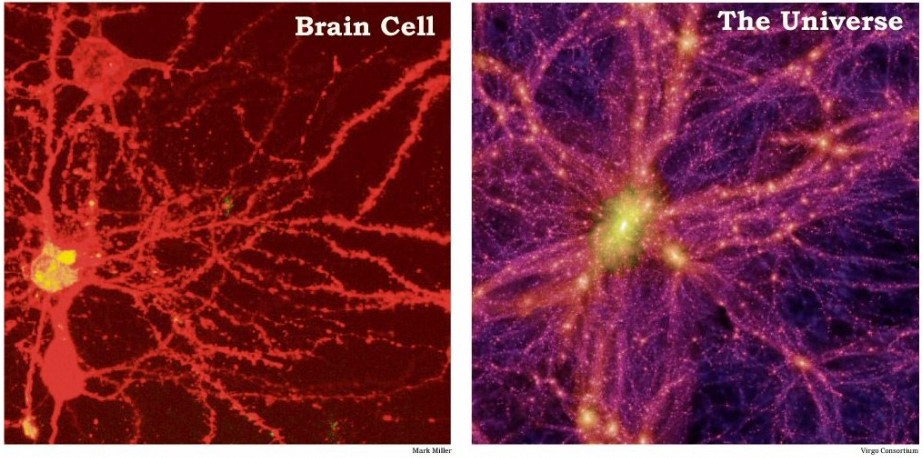There is a strange similarity of neural networks and galaxies of universe
Christof Koch, a leading researcher on consciousness and the human brain, has called the brain “the most complex object in the known universe.
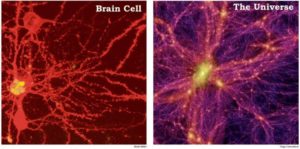
of a neuron and connections in the brain (L); Virgo Consortium for Cosmological Supercomputer Simulations, of the large-scale structure of the Universe (R), via visualcomplexity.com and the New York Times.
With a hundred billion neurons and a hundred trillion connections, the brain is an object of dizzying complexity.
But there are many other complicated objects in the universe.
Striking similarities
For example, galaxies can cluster into huge structures (called clusters, superclusters, and filaments) that span hundreds of millions of light-years.
The boundary between these structures and nearby expanses of empty space called cosmic voids can be extremely complex.
Gravity accelerates matter at these boundaries to speeds of thousands of miles per second, creating shock waves and turbulence in the intergalactic gases.
We predicted that the void-filament boundary is one of the most complex volumes in the universe, as measured by the number of bits of information it takes to describe it.
It made us think: is it more complex than the brain?
We, astrophysicist and neuroscientist, have therefore joined forces to quantitatively compare the complexity of galaxy networks and neural networks.
The first results of our comparison are truly surprising: not only are the complexities of the brain and the cosmic web really similar, but so are their structures.
The universe can be self-similar across scales that differ in size by a factor of a billion billion billion.
On the one hand, this requires processing data obtained in radically different ways. The telescopes and digital simulations on the one hand, electron microscopy, immunohistochemistry and functional magnetic resonance on the other.
It also forces us to consider vastly different scales: the entire cosmic web—the large-scale structure traced by all the galaxies in the universe—spans at least a few tens of billions of light-years.
That’s 27 orders of magnitude larger than the human brain.
Moreover, one of these galaxies is home to billions of real brains.
If the cosmic web is at least as complex as any of its constituent parts, we might naively conclude that it must be at least as complex as the brain.
The total number of neurons in the human brain is in the same range as the number of galaxies in the observable universe.
But the concept of emergence makes the comparison possible.
Many natural phenomena are not equally complex at all scales.
The majestic web of the cosmic web only becomes evident when the sky is surveyed to its fullest extent.
On a smaller scale, with matter locked in stars, planets and (probably) clouds of dark matter, this structure is lost.
An evolving galaxy does not care about the dance of electron orbitals in atoms, and electrons move around their nuclei without regard to the galactic system in which they reside.
In this way, the universe contains many systems nested within systems, with little or no interaction at different scales.
This scale segregation allows us to study physical phenomena as they emerge at their own natural scales.
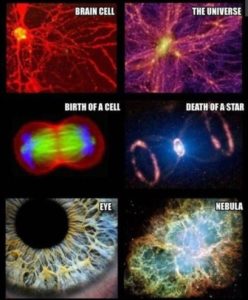
The building blocks of the cosmic web are the self-gravitating halos of stars, gas and dark matter (whose existence has not yet been definitively proven).
In total, the number of galaxies within the observable universe should be of the order of 100 billion.
The balance between the accelerated expansion of the fabric of spacetime and the pull of self-gravity gives this web its cobweb-like pattern.
Ordinary and dark matter condenses into string-like filaments, and clusters of galaxies form at the intersections of the filaments, leaving most of the remaining volume virtually empty.
The resulting structure looks vaguely biological
A direct estimate of the number of cells or neurons in the human brain was not available in the literature until recently.
Cortical gray matter (representing more than 80% of brain mass) contains about 6 billion neurons (19% of brain neurons) and nearly 9 billion non-neuronal cells.
The cerebellum has about 69 billion neurons (80.2% of brain neurons) and about 16 billion non-neuronal cells.
Interestingly, the total number of neurons in the human brain is in the same range as the number of galaxies in the observable universe.
The eye immediately grasps a certain similarity between the images of the cosmic web and the brain.
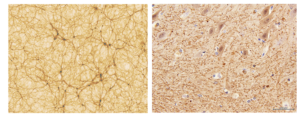
In Figure 1 , we show a simulated distribution of cosmic matter in a slice 1 billion light-years across, as well as an actual image of a 4 micrometer (µm) thick slice through the cerebellum human.
Is apparent similarity simply the human tendency to perceive meaningful patterns in random data (apophenia)?
Remarkably enough, the answer seems to be no: statistical analysis shows that these systems do indeed have quantitative similarities.
Researchers routinely use a technique called power spectrum analysis to study the large-scale distribution of galaxies.
The power spectrum of an image measures the strength of structural fluctuations belonging to a specific spatial scale.
In other words, it tells us how many high and low frequency notes make up the particular spatial melody of each image.
A startling message emerges from the power spectrum plot in Figure 2 (below): the relative distribution of fluctuations in the two networks is remarkably similar, over several orders of magnitude.
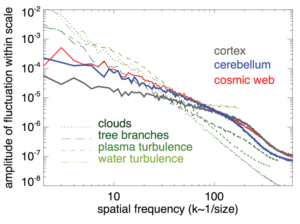
The distribution of fluctuations in the cerebellum at scales of 0.1 to 1 mm is reminiscent of the distribution of galaxies over hundreds of billions of light years.
At the smallest scales accessible to microscopic observation (around 10 µm), it is the morphology of the cortex that comes closest to that of galaxies, at scales of a few hundred thousand light-years.
In comparison, the power spectra of other complex systems (including projected images of clouds, tree branches, and plasma and water turbulence) are quite different from those of the cosmic web.
The power spectra of these other systems display stronger scale dependence, which may be a manifestation of their fractal nature.
This is particularly striking for the distribution of branches in trees and in the cloud pattern, both of which are well known to be fractal-like systems with self-similarity across a wide variety of scales.
For the complex networks of the cosmic web and the human brain, on the other hand, the observed behavior is not fractal, which can be interpreted as evidence for the emergence of scale-dependent self-organizing structures.
Total memory capacity
Estimating the complexity of the human brain is much more difficult, as whole-brain simulations remain an unmet challenge.
However, we can say that complexity is proportional to intelligence and cognition.
Based on the latest analysis of brain network connectivity, independent studies have concluded that the total memory capacity of the adult human brain should be around 2.5 petabytes, not far from the estimated 1-10 petabyte range. for the cosmic web.
Conclusion
It is truly a remarkable fact that the cosmic web is more like the human brain than the interior of a galaxy; or that the neural network is more like the cosmic web than inside a neural body.
Despite extraordinary differences in substrate, physical mechanisms, and size, the human neural network and the cosmic network of galaxies, when viewed with the tools of information theory, are strikingly similar.
Programs like the Human Brain Project, designed to simulate an entire human neural network, and the Square Kilometer Array, the largest endeavor ever in radio astronomy, will help us fill in some of these details and understand if the universe is even more surprising than us. thought.
Franco Vazza is a member of the Marie Curie Slodowska Action of Horizon 2020, at the Institute of Radio Astronomy, INAF, Bologna, Italy.
Alberto Feletti is a member of the Department of Neurosurgery at NOCSAE Hospital, Azienda Ospedaliero-Universitaria di Modena, Italy.
We would like to thank Dr. Elena Zunarelli (Department of Anatomical Pathology, University Hospital Policlinico di Modena, Modena, Italy) for producing the slices through the cortex and cerebellum in Figure 1.
References 1. Vazza, F. On the complexity and information content of cosmic structures. Royal Astronomical Society Monthly Notices 465, 4942-4955 (2017).
